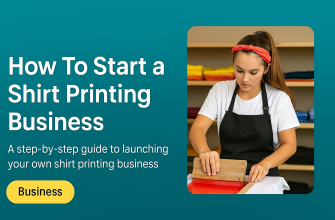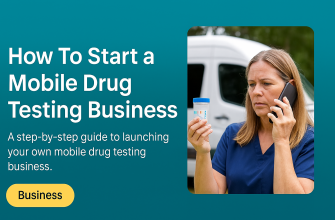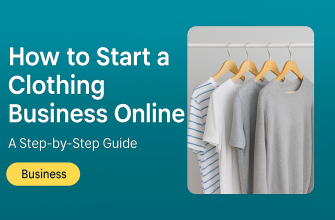Dreaming of owning your own boutique is exciting – and entirely possible! Boutiques stand apart by offering unique, limited-edition products and a warm, personalized shopping experience. Think of your boutique as a story: every piece you carry and every interaction you have is part of that story. You want customers to feel that personal touch and passion behind each item. As you plan this new adventure, remember that you don’t need prior business experience to succeed. With passion, preparation, and a step-by-step approach, you can turn your boutique dream into reality.
- Discover Your Passion and Niche
- Create Your Business Plan
- Choose Your Location (Or Online Platform)
- Budget Wisely and Set Financial Goals
- Source Your Products
- Build Your Brand and Store Experience
- Marketing Your Boutique
- Manage Money and Growth
- Legal and Administrative Essentials
- Take the First Step – You’ve Got This
Discover Your Passion and Niche
The first step is to get clear on what makes your boutique special. Ask yourself: what are you passionate about? Is it chic home décor, organic lifestyle goods, trendy fashion, or something else? Your answer forms the foundation of your boutique’s identity. Experts emphasize that having a clear niche helps customers quickly understand what you do and how they’ll benefit. For example, you might focus on eco-friendly fashion for busy moms, vintage-inspired home goods, or artisanal jewelry. The more specific, the better – it guides your product choices and marketing.
By focusing on a niche, you establish yourself as an expert in that area and make it easier to reach the right customers. Think of it as finding your unique selling proposition (USP). Revisit why you want to start this boutique: your personal story and interests will point to what you should be known for. Maybe you’ve always loved sustainable fashion, or have a knack for handcrafting candles. That enthusiasm will translate into unique products and authentic messaging. Once you know your niche, you can begin researching the market: Who are your ideal customers? What problems do your products solve for them? Understanding this lets you design a store and marketing plan that truly resonates with your audience.
Create Your Business Plan
A simple business plan is your roadmap to success. It doesn’t have to be hundreds of pages, but it should cover the essentials: your vision, target market, products, operations, and finances. Think of it as the foundation of your business. The U.S. Small Business Administration reminds us that “a good business plan guides you through each stage of starting and managing your business”. In other words, it helps you think through key details and stay organized.
Your plan can include sections like:
-
Mission and Vision: What change or feeling do you want to create for your customers?
-
Market Research: Who are your customers (age, interests, needs) and who are your competitors?
-
Products and Sourcing: What will you sell, and where will those products come from (wholesale suppliers, local artisans, or something you make)?
-
Sales and Marketing Strategy: How will customers learn about and buy from your boutique (social media, local events, a website)?
-
Financial Plan: Estimate your startup costs and project your first year’s sales.
You’ll refine this plan as you learn more, but even a draft helps clarify your goals. For example, it forces you to estimate how much you might spend on inventory, rent or website fees, and how much you need to sell to break even. Having these ideas written down makes decisions easier and can boost your confidence. And if you ever need a loan or a partner, a clear plan will show others that you’re serious about making this work.
Choose Your Location (Or Online Platform)
Next, decide where your boutique will live. You have two main options: a physical store, an online shop, or a combination of both. Each has pros and cons, and many boutiques today do a bit of both.
-
Brick-and-Mortar Store: A physical location gives customers an immediate brand experience – they walk in, touch products, and build a connection with you. If you go this route, pick a spot with good foot traffic and the right customers nearby. Busy shopping streets, malls, or trendy neighborhoods can bring people in, but they also cost more in rent. Remember, “you can’t sell your product if there aren’t enough people to buy it,” so choose a location with steady visitorsgeoiq.ai. Also consider demographics: does the local area match your ideal customer’s age, interests, and incomegeoiq.ai? For example, a children’s boutique would do better near family communities, whereas upscale fashion thrives in areas where shoppers have higher budgets. Balancing these factors is key. Keep in mind that opening a retail store is a serious investment – studies show the average small retail launch costs around $40,000 (and can be more depending on size and location). This includes lease deposits, inventory, displays, and initial marketing.
-
Online Store: An e-commerce site (your own website or a platform like Shopify, Etsy or even Instagram shops) lets you reach customers everywhere, often with lower overhead. Building a professional website is now a must-have for any store. A great site acts like your 24/7 showcase – it should clearly tell your brand story and show your products in the best light. Online, you’ll still need to think about visibility: use social media and search engine strategies (like relevant keywords and hashtags) so people can discover you. If you start online, you might also consider platforms like Etsy (for handmade and vintage goods) or Shopify (for a full-featured shop), which simplify setup.
-
Hybrid (Both): Many modern boutiques have both a small studio or pop-up shop and a strong online presence. This way, local customers can visit in person and online customers across the country can shop anytime. If you can manage it, having both channels diversifies your reach.
No matter which path you choose, the key is to ensure customers can easily find you. If you go physical, make your store welcoming and easy to navigate. If you go online, make your website user-friendly and mobile-ready. And always factor costs: compare rent and utilities for a storefront versus website hosting and shipping costs for an online shop.
Budget Wisely and Set Financial Goals
With your location in mind, it’s time to plan your budget carefully. List all the costs you’ll have: rent or domain fees, inventory purchases, store fixtures (racks, shelves, decor), website development, marketing (business cards, launch event, online ads), and so on. Don’t forget small expenses like packaging materials, signage, and transaction fees.
Experts suggest setting concrete sales and profit goals to guide you. For example, decide how much you need to sell each month to cover costs and make a profit. Break it down: which products will sell well and bring in the most profit? The Chron small-business guide recommends regularly identifying your best-selling items and focusing on those (while gently rotating or updating slower sellers). This helps your inventory match customer demand and keeps cash flowing.
Track every dollar: open a separate business bank account and use simple accounting tools (even a spreadsheet at first) to record sales and expenses. When you have real numbers on hand, adjust your spending and pricing. If something costs more than expected (like higher rent or supplier price changes), you’ll need to tweak your plan or prices. Conversely, if you find ways to save (a cheaper supplier, a bulk discount), pass those savings on or increase your profit margin. Remember, having a clear budget and monitoring it helps you avoid surprises and keeps your business on stable ground.
Source Your Products
Your products are the heart of your boutique. You want items that excite you and your customers. There are several ways to source inventory:
-
Wholesale Suppliers: Buying from wholesalers or distributors means ordering pre-made products in bulk at lower prices. You can find wholesalers at trade shows, online marketplaces (like Faire or Alibaba), or local markets. The upside is they often handle shipping, customs, and storage logistics, so you just place your order and pay. This simplifies getting a variety of products into your store. The downside is that many other retailers may sell the same items, so you’ll compete on branding and price.
-
Create or Curate Your Own Products: If you have a craft (like handmade candles, knitting, art, etc.) or can commission unique items, this gives your boutique exclusive merchandise. You’ll control every detail, and customers love one-of-a-kind goods. However, making products yourself or hiring artisans means more time and cost for production. You must manage materials, labor, and inventory. It can be very rewarding, but start small to make sure you can keep up with demand.
-
Drop-Shipping: This method lets you sell products without holding inventory. You partner with a supplier who stocks the items and ships directly to your customers. Your main job is to list those products on your site or social media and take orders. When something sells, you (or your store system) notify the supplier, and they pack and ship it. Dropshipping is appealing because it requires low upfront investment and no storage space. You only pay for products after you’ve sold them. The trade-off is generally thinner profit margins and less control over packaging and shipping speed. But for a beginner, it can be a way to test what sells before buying large quantities.
-
Local Artisans and Consignment: Consider collaborating with local makers (artists, jewelry designers, home-goods crafters). Selling consignment means you display others’ products and pay them a portion only after you sell. This adds unique local flair and supports your community. It does require clear agreements and good relations with each artisan.
No matter the method, always vet your sources. Order samples first to check quality. If you use wholesalers, compare prices from multiple vendors. If you sell handmade goods, understand your production cost so you price them for profit. And keep your assortment fresh – regularly look for new products or trends to keep customers coming back. As one sourcing guide advises, the process is ongoing: you should continuously seek better products and suppliers to keep your offerings inspiring. In practice, this means staying curious, researching competitors, and always tasting new things in the market.
Build Your Brand and Store Experience
Your brand is the personality of your boutique. It’s how people feel when they interact with you. Branding encompasses much more than just a logo; it’s your color scheme, your “voice” on social media, the style of your store decor, and even the type of shopping bags you use. Strong branding builds trust, recognition, and loyalty over time. For example, think of how the Nike swoosh or the phrase “Just Do It” instantly remind you of the brand’s promise. Your boutique needs a similarly clear message.
-
Develop a Visual Identity: Choose a color palette and logo that reflect your niche. For instance, a rustic home décor shop might use earthy tones and a hand-lettered logo, while a chic fashion boutique might use sleek black-and-white and a modern font. The key is consistency: use the same colors and logo style on your website, business cards, storefront sign, price tags, and marketing materials. The Chron guide stresses that a boutique’s advertising should highlight the uniqueness of its merchandise, and that the store should have a “consistent design for its logo and color scheme” across all materials. This way, no matter where customers encounter you – online or in person – they recognize your brand.
-
Craft a Memorable Story: What story are you telling? Maybe it’s that your products are ethically sourced, or handmade with love, or that they celebrate a certain culture or aesthetic. Use your website and social media captions to share this story. Customers connect more with a brand when they feel it has values. According to branding experts, small-business branding is about “who your company is, its brand personality, its voice, its purpose”. Let those show in your words and images. For example, if your niche is eco-friendly goods, regularly share tips on sustainable living; if it’s bridal wear, post behind-the-scenes shots of dress fittings or wedding inspiration.
-
Design the Store Layout: Whether online or offline, the “store” layout should be welcoming and logical. If you have a physical shop, arrange products in well-defined sections (e.g., new arrivals, sale items, different categories) so customers can browse easily. Provide a cozy nook or seating if you can – a short wait in a nice area can make customers feel cared for. In your online shop, organize products into clear collections or categories and make sure there’s an easy checkout process. Everywhere a customer steps, they should feel the same vibe and quality.
-
Deliver Excellent Service: This is an essential part of your brand experience. Train anyone helping you (or yourself) to be knowledgeable, friendly, and enthusiastic. In a boutique, customers expect a more personal touch than in big-box stores. For instance, you might greet first-time visitors, offer styling tips, or write a handwritten thank-you note with each order. By creating a warm customer experience, you turn buyers into repeat customers and brand ambassadors. As one retail advisor notes, boutique sales staff are typically “more customer-friendly” and focus on telling each item’s story to the shopper. You can apply this online by answering questions quickly, offering styling advice via chat, or sending follow-up emails after a purchase.
Marketing Your Boutique
With your niche, plan, location, products, and brand in place, it’s time to spread the word. A good marketing strategy will attract customers and build lasting relationships. Use both online and offline methods:
-
Online Presence: Today, having an active social media presence is almost mandatory for small businesses. Consumers expect to find you there – in fact, “statisticians show a majority of people discover products via social media feeds,” and having profiles on popular platforms lends credibility. Start with the platforms where your customers spend time. Instagram and Pinterest are great for boutiques because they’re image-focused – post beautiful photos of your products, styling ideas, and behind-the-scenes glimpses. Facebook and Twitter can also be useful for community building and quick updates. Consistently post and engage with followers by answering comments and messages. Use relevant hashtags and even consider small paid ads or partnerships with influencers (local fashion bloggers, for example) to increase visibility.
-
Website and Content: Make sure your website is professional and user-friendly. It should tell your story, display your products clearly, and explain how to buy (and return) them. Start a blog or newsletter if you can: share tips related to your products (e.g., “How to Style Vintage Tees” or “5 Ways to Create a Cozy Home”), spotlight new arrivals, or feature customer stories. This content not only helps with marketing but also improves your website’s search ranking so more people find you online.
-
Local Marketing: Don’t neglect traditional word-of-mouth and community marketing. Host a grand opening event or pop-up sale to introduce your boutique. Partner with complementary local businesses (like a coffee shop or a yoga studio) for cross-promotions. Distribute flyers or postcards in the neighborhood, and always have business cards handy to give to curious visitors. One marketing plan note is to emphasize your boutique’s uniqueness in every ad or flyer. When you run ads (in newspapers or online) or send promotional mailings, highlight what makes you special—your curated selection, your customer service, or any special launch offers.
-
Consistent Branding in Ads: Whenever you create marketing materials (online posts, flyers, signs), use your brand’s logo and colors consistently. A cohesive look across channels reinforces recognition. Customers should feel the same vibe whether they see you on Instagram, enter your store, or visit your website. Over time, this consistent branding builds trust – people feel confident buying from a brand they recognize and like.
No matter which channels you use, remember: marketing isn’t just blasting messages. It’s about conversation. Encourage customers to sign up for your email list for exclusive updates or discounts, and thank them for referrals. Show your brand’s human side: share a “Meet the Owner” post or highlight satisfied customers (with permission). By being authentic and engaging, you turn marketing into relationship-building.
Manage Money and Growth
Even after launch, keep a close eye on your finances and growth. Revisit your budget regularly and adjust as needed. Are certain products flying off the shelves? Order more of those. Are some expenses higher than expected? Find ways to cut costs (for example, buying supplies in bulk or negotiating a better shipping rate). Keep track of which marketing efforts are working – if Facebook ads aren’t bringing sales, maybe try Instagram or a local event instead.
Set and review sales goals: for instance, you might decide “we need to sell 50 items this month to cover costs and earn profit.” Then check weekly progress. The Chron guide recommends measuring the return on investment (ROI) for every marketing dollar spent. This could mean comparing advertising costs to the sales they generated. Use simple charts or spreadsheets to visualize trends over time.
As orders come in, manage inventory carefully so you don’t run out of popular items or overstock slow ones. Consider using basic inventory software or apps if things get complex, or even a detailed spreadsheet at first. Good inventory management ensures that when a customer asks for that hot new item, you have it ready – and prevents tying up cash in items that don’t sell. Always keep a little cash reserve (an emergency fund) in your budget for unexpected expenses, like equipment repairs or a new marketing opportunity.
Legal and Administrative Essentials
While focusing on passion and products, don’t forget the legal side of business. Tackling these basics early will save headaches later:
-
Choose a Business Structure: Decide whether you’ll be a sole proprietor, an LLC, or another type of entity. Many small boutiques start as an LLC because it separates personal and business liability, but check your local rules. This choice affects your taxes and personal responsibility if things go wrong.
-
Register Your Business Name: Almost all businesses need to register a name with state or local agencies. Even if you operate as “you” using your legal name, consider filing a “Doing Business As” (DBA) if you want a shop name. According to the SBA, “for most small businesses, registering your business is as simple as registering your business name with state and local governments”. Doing this makes your boutique a legal entity and can protect your personal assets.
-
Get Licenses and Permits: Check if you need any licenses or permits. Retail businesses often need a sales tax permit or a general business license. If you sell anything consumable (like soap or food), health permits may apply. Failure to have the right permits can lead to fines. A small-business legal guide reminds new ventures to “comply with all the legal requirements” including taxes, financial regulations, and (if you hire staff) employment laws. Research your city and state requirements or use a local business resource to make a checklist.
-
Tax IDs and Banking: Obtain an Employer Identification Number (EIN) from the IRS (this is often needed even for a sole proprietor). It’s free and simple to get online. Use this EIN to open a business bank account and credit card. Keeping business finances separate from personal finances is crucial for clarity and tax time.
-
Insurance: Look into business insurance, such as general liability insurance, to protect against claims. If you have a physical store, landlord may require insurance. If you have employees, you’ll need workers’ comp insurance.
Taking care of these legal steps at the start ensures you avoid pitfalls. In fact, experts note that complying with these obligations is vital so you can focus on growing your business. It may feel like a lot of paperwork, but breaking it into small tasks (register name one day, set up the bank account another) will make it manageable.
Take the First Step – You’ve Got This
Starting any business comes with nerves. You might worry, “What if I fail?” or “Do I really have what it takes?” The truth is, fear is a part of the journey. As one expert puts it, “failure is a part of life, and it’s often a part of running your own business. All entrepreneurs need to accept this fear…and come to a certain level of comfort with it, if they are to succeed”. Recognizing this helps – every successful boutique owner has felt uncertainty at the beginning.
Remember the wisdom of Lao Tzu: “The journey of a thousand miles begins with a single step.” That first step might feel like a leap, but it’s really just starting – maybe writing down your business idea on paper, sketching a logo, or chatting with a potential mentor. You don’t need to have everything perfect right away. Start small: make a simple to-do list today. Check off one item, like researching suppliers or choosing a business name. Each task you accomplish builds confidence and momentum.
Be your own biggest cheerleader. You’re turning a passion into a career, and that’s powerful. It’s normal to have doubts, but also remember why you started. Your unique perspective and creativity are exactly what will make your boutique special. Seek support from other entrepreneurs – whether through online groups for women in business, local small-business meetups, or a mentor who believes in you. Many women entrepreneurs thrive by lifting each other up.
You can do this. You are building something unique that reflects you – your taste, your values, your dreams. Start taking those steps one by one: define your niche, write your plan, pick a location (even if it’s online), gather products, and tell your story to the world. With passion, persistence, and the practical steps above, you will be well on your way to opening your boutique doors. Your customers are waiting to discover you and your creations.









